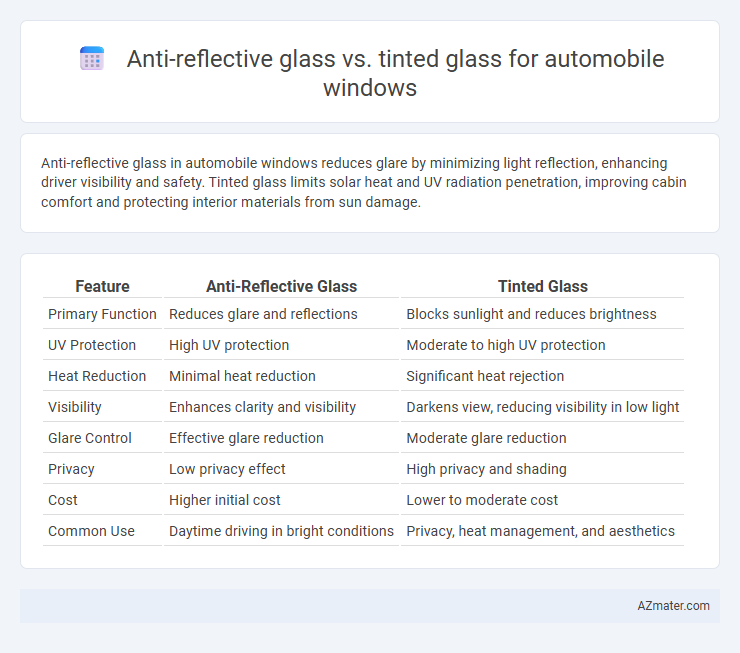Anti-reflective glass in automobile windows reduces glare by minimizing light reflection, enhancing driver visibility and safety. Tinted glass limits solar heat and UV radiation penetration, improving cabin comfort and protecting interior materials from sun damage.
Table of Comparison
| Feature | Anti-Reflective Glass | Tinted Glass |
|---|---|---|
| Primary Function | Reduces glare and reflections | Blocks sunlight and reduces brightness |
| UV Protection | High UV protection | Moderate to high UV protection |
| Heat Reduction | Minimal heat reduction | Significant heat rejection |
| Visibility | Enhances clarity and visibility | Darkens view, reducing visibility in low light |
| Glare Control | Effective glare reduction | Moderate glare reduction |
| Privacy | Low privacy effect | High privacy and shading |
| Cost | Higher initial cost | Lower to moderate cost |
| Common Use | Daytime driving in bright conditions | Privacy, heat management, and aesthetics |
Introduction to Automotive Glass Technologies
Anti-reflective glass in automobiles enhances driver visibility by reducing glare from sunlight and headlights, improving safety during night driving and bright conditions. Tinted glass primarily offers UV radiation protection and heat reduction, contributing to passenger comfort and interior preservation by limiting solar heat gain. Both technologies play crucial roles in automotive glass advancements, addressing distinct needs for safety, comfort, and energy efficiency.
What is Anti-Reflective Glass?
Anti-reflective glass for automobile windows features a specialized coating that minimizes glare and reflections, enhancing visibility and driving safety under various lighting conditions. Unlike tinted glass, which reduces the amount of light entering the vehicle by darkening the windows, anti-reflective glass maintains natural light transmission while significantly decreasing surface reflections. This technology improves driver comfort and reduces eye strain without compromising window transparency or aesthetic appeal.
What is Tinted Glass?
Tinted glass for automobile windows is specially treated to reduce sunlight and glare by adding a thin film or coloring during manufacturing, enhancing privacy and UV protection. Unlike anti-reflective glass, which minimizes surface reflections to improve visibility and reduce eye strain, tinted glass primarily blocks heat and harmful ultraviolet rays. This makes tinted glass ideal for maintaining cooler interior temperatures and protecting occupants from ultraviolet damage while driving.
Key Differences Between Anti-Reflective and Tinted Glass
Anti-reflective glass for automobile windows reduces glare by minimizing light reflection, enhancing visibility and driver safety, whereas tinted glass primarily blocks sunlight to reduce heat and UV exposure inside the vehicle. Anti-reflective coatings improve optical clarity without significantly altering window transparency, while tinted glass darkens windows to provide privacy and sun protection. The choice between anti-reflective and tinted glass depends on whether reducing glare or controlling sunlight and heat is the primary concern for the vehicle owner.
Light Transmission and Visibility
Anti-reflective glass for automobile windows enhances light transmission by reducing glare and reflections, significantly improving visibility for drivers, especially in bright conditions. Tinted glass decreases overall light transmission to reduce interior heat and glare but may compromise visibility in low-light or nighttime situations. Choosing between the two depends on the priority of maximizing clarity versus controlling brightness and privacy.
UV and Infrared Protection Comparison
Anti-reflective glass significantly reduces glare and enhances visibility by minimizing surface reflections, but its UV and infrared protection is typically moderate, blocking up to 70% of UV rays and some infrared heat. Tinted glass offers superior UV protection, often blocking up to 99% of harmful ultraviolet radiation, and excels in infrared rejection, which helps maintain cooler cabin temperatures by reducing heat from sunlight. For comprehensive protection against UV and infrared radiation in automobile windows, tinted glass generally outperforms anti-reflective glass, especially in heat reduction and occupant comfort.
Impact on Driver Comfort and Safety
Anti-reflective glass significantly reduces glare from sunlight and headlights, enhancing driver visibility and minimizing eye strain during long drives or nighttime conditions. Tinted glass lowers interior heat by blocking UV rays and reduces glare, but excessive tinting may impair visibility in low-light scenarios, potentially compromising safety. Optimal driver comfort and safety depend on balancing glare reduction and visibility, where anti-reflective coatings improve clarity while tinting offers thermal comfort.
Aesthetic Considerations and Customization Options
Anti-reflective glass enhances automobile window aesthetics by minimizing glare and reflections, creating a sleek, clear appearance that improves visibility and driving comfort. Tinted glass offers diverse customization options with varying shades and colors, allowing vehicle owners to personalize their car's look while providing privacy and reducing interior heat. Both options contribute uniquely to a car's exterior style, with anti-reflective glass emphasizing clarity and sophistication, while tinted glass emphasizes style variety and UV protection.
Cost and Maintenance Factors
Anti-reflective glass for automobile windows typically incurs higher initial costs due to advanced coating technologies that reduce glare and enhance visibility, but it demands minimal maintenance beyond regular cleaning since the coating is durable. Tinted glass generally offers a lower upfront price and provides benefits like UV protection and heat reduction; however, it may require more frequent care to prevent fading, peeling, or discoloration over time. Evaluating long-term expenses, anti-reflective glass often proves more cost-effective due to reduced maintenance needs, while tinted glass may incur additional costs for re-tinting or replacement.
Which Is Better: Anti-Reflective or Tinted Glass for Cars?
Anti-reflective glass enhances visibility by reducing glare and eye strain, making it ideal for night driving and safety. Tinted glass offers superior heat rejection and UV protection, helping maintain cooler cabin temperatures and protecting interiors from sun damage. The choice depends on driving conditions and priorities: anti-reflective glass improves clarity and safety, while tinted glass focuses on comfort and protection.

Infographic: Anti-reflective glass vs Tinted glass for Automobile window
 azmater.com
azmater.com